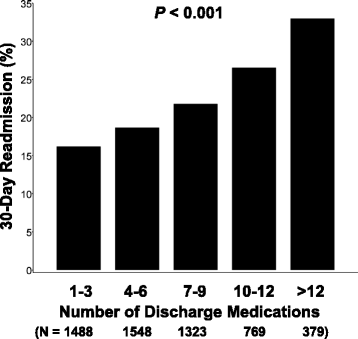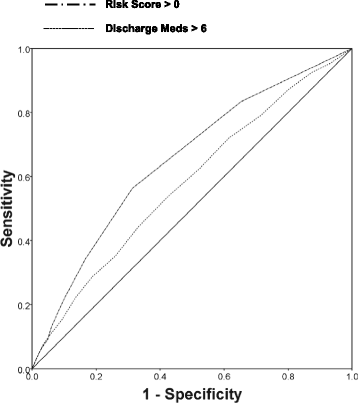The number of discharge medications predicts thirty-day hospital readmission: a cohort study
- PMID: 26202163
- PMCID: PMC4512093
- DOI: 10.1186/s12913-015-0950-9
The number of discharge medications predicts thirty-day hospital readmission: a cohort study
Abstract
Background: Hospital readmission occurs often and is difficult to predict. Polypharmacy has been identified as a potential risk factor for hospital readmission. However, the overall impact of the number of discharge medications on hospital readmission is still undefined.
Methods: To determine whether the number of discharge medications is predictive of thirty-day readmission using a retrospective cohort study design performed at Barnes-Jewish Hospital from January 15, 2013 to May 9, 2013. The primary outcome assessed was thirty-day hospital readmission. We also assessed potential predictors of thirty-day readmission to include the number of discharge medications.
Results: The final cohort had 5507 patients of which 1147 (20.8 %) were readmitted within thirty days of their hospital discharge date. The number of discharge medications was significantly greater for patients having a thirty-day readmission compared to those without a thirty-day readmission (7.2 ± 4.1 medications [7.0 medications (4.0 medications, 10.0 medications)] versus 6.0 ± 3.9 medications [6.0 medications (3.0 medications, 9.0 medications)]; P < 0.001). There was a statistically significant association between increasing numbers of discharge medications and the prevalence of thirty-day hospital readmission (P < 0.001). Multiple logistic regression identified more than six discharge medications to be independently associated with thirty-day readmission (OR, 1.26; 95 % CI, 1.17-1.36; P = 0.003). Other independent predictors of thirty-day readmission were: more than one emergency department visit in the previous six months, a minimum hemoglobin value less than or equal to 9 g/dL, presence of congestive heart failure, peripheral vascular disease, cirrhosis, and metastatic cancer. A risk score for thirty-day readmission derived from the logistic regression model had good predictive accuracy (AUROC = 0.661 [95 % CI, 0.643-0.679]).
Conclusions: The number of discharge medications is associated with the prevalence of thirty-day hospital readmission. A risk score, that includes the number of discharge medications, accurately predicts patients at risk for thirty-day readmission. Our findings suggest that relatively simple and accessible parameters can identify patients at high risk for hospital readmission potentially distinguishing such individuals for interventions to minimize readmissions.
Figures



References
Publication types
MeSH terms
Grants and funding
LinkOut - more resources
Full Text Sources
Other Literature Sources

